The vast expanse of the night sky is adorned with an endless array of stars. Amidst the vast variety of celestial bodies, such as distant suns, galaxies, black holes, and other fascinating objects scattered throughout the boundless universe, there exists a unique category of space entities that captivate scientists with their extraordinary characteristics: neutron stars. These astronomical marvels possess an astonishingly massive composition, yet are remarkably compact in size. In this article, we delve into the enigmatic nature of neutron stars, a subject that continues to pique the curiosity of inquisitive minds in the scientific community.
Neutron stars possess an astonishingly compact size and an astounding level of mass – their gravitational pull rivals that of the sun, and on occasion, surpasses it.

According to research conducted by astrophysicists from Germany, the mass of non-rotating neutron stars can sometimes be more than twice the mass of the Sun, while their average radius is between 10 and 20 kilometers. If we were to take a teaspoon of any substance from the Earth’s surface, its mass would only be around a kilogram, whereas the same volume of matter taken from the densest neutron stars would weigh tens of billions of tons.
The structure of neutron stars is organized as follows: the outermost layer, known as the crust, is made up of atomic nuclei and electrons, while the rest of the volume is composed of a “neutron liquid”. At the center of the neutron star lies the nucleus. The layers of the neutron star are typically divided into five parts: the atmosphere, the outer and inner portions of the crust, and the outer and inner core.
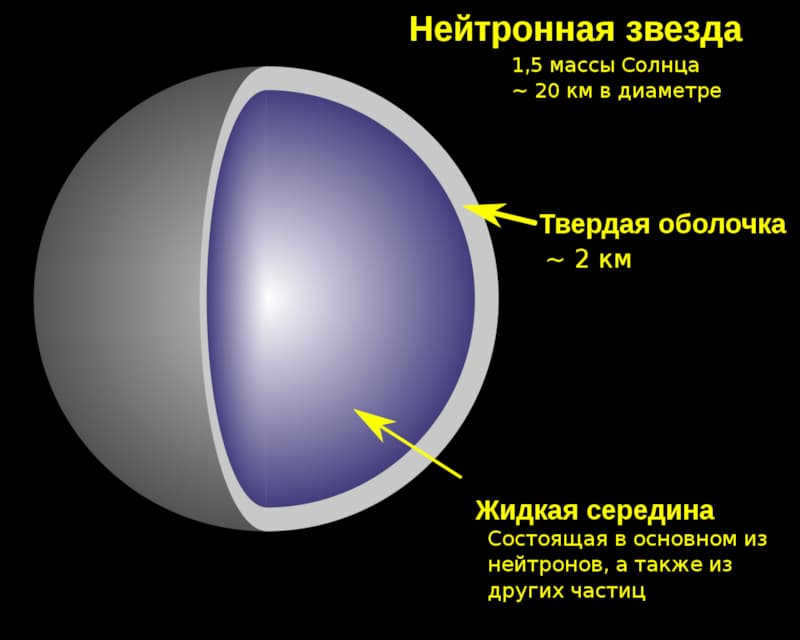
Because of the incredibly dense composition of matter in a neutron star, which averages about 10^19 kg/m^3, and its minuscule size, the gravitational pull on its surface creates a free fall acceleration that is 100 billion times greater than that on Earth. The immense gravity of this celestial body causes objects to fall towards it with such force that upon impact with its crust, the matter would instantaneously disintegrate into neutrons.
Objects in space known as cosmic entities are formed following the detonation of supernovae. After undergoing a series of transformations, they experience several “metamorphoses”. As for the query regarding the fate of stars, it can be answered as follows: celestial bodies with insufficient mass, such as our very own Sun, shed their outer layers and become white dwarfs; if the mass meets the required threshold, the collapsed star becomes a black hole, otherwise, it becomes a neutron star.
The discovery of the neutron in 1932 by James Chadwick was a significant scientific breakthrough. However, prior to this discovery, Lev Landau, a scientist from the USSR, had already predicted in his work published in the winter of 1931 that there would be a violation of the laws of quantum mechanics in the near future. Landau, a Soviet theoretical physicist, hypothesized that this violation would occur when matter reached a high density, causing atomic particles to come together and form a massive nucleus.
In the early 1933, two astronomers named Fritz Zwicky and Walter Baade made the initial assertion that a neutron star is indeed an existing object. They presented several justifications to support their own theory about the formation of neutron luminosity after a supernova explosion. These studies revealed that the emissions emitted by neutron stars were not detected at the time due to the limited optical equipment available during that period.
In 1967, in Cambridge, Jocelyn Bell observed radio pulses emanating from stars that are now recognized as highly magnetized and rapidly rotating cosmic bodies called pulsars. This discovery ultimately led to the identification of the very first neutron star in history.
Classification of neutron stars
Neutron stars interact with their surroundings based on two primary factors – their rotational speed and the strength of their magnetic field. As these stars evolve, they gradually slow down, resulting in a decrease in their magnetic field strength. This ultimately leads to the categorization of neutron stars into various types.
Here is a list of neutron stars in order of decreasing rotation period:
1) Slow Rotators with High Magnetic Fields: These neutron stars have a high magnetic field strength but rotate at a relatively low speed. When the rotation reaches a critical radius, close to the speed of light, the typical dipole field fails to function properly, resulting in breaks. As a result, charged particles are expelled into interstellar space. On Earth, these neutron stars are known as radio pulsars.
2) Propeller Neutron Stars: These neutron stars are characterized by their ability to "propel" or expel charged particles due to their rotation. They possess a moderate magnetic field strength and a moderate rotational speed.
Because of the slow rotation speed, there is no ejection of particles, making this type of object incapable of becoming a radio pulsar. However, the velocity is sufficient to prevent matter from falling onto the surface.
3) Accretors:
The velocity is reduced to the point where matter freely falls onto the neutron body, causing its poles to heat up and its temperature to rise by millions of degrees. Once heated, the matter emits a bright glow, which is why these objects are called X-ray pulsars.
4) Georotators:
The rotation speed is low, which doesn’t hinder accretion. However, due to the specific size of the magnetosphere, the magnetic field stops the plasma before it collides with gravity. A similar phenomenon occurs in Earth’s magnetosphere.
5) Ergostars:
This is the designation for a hypothetically existing type of neutron objects with an ergosphere, which is believed to form when two rotating neutron stars merge.
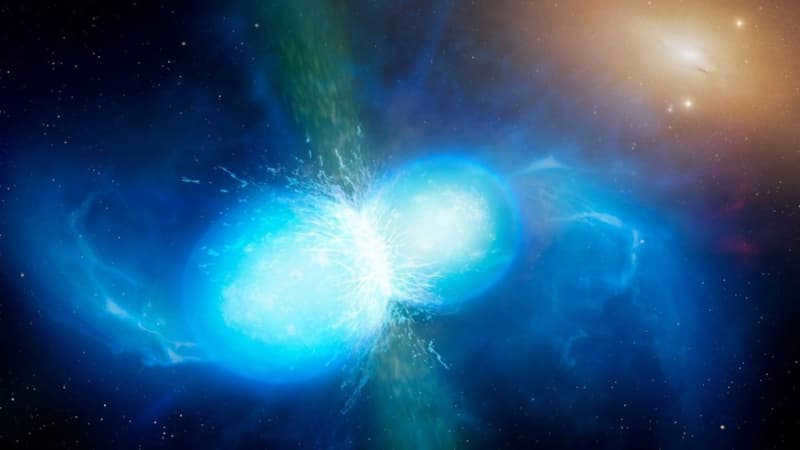
“Magnetic” stars
Stars belonging to this classification possess an immensely powerful magnetic field, which surpasses that of any magnet created artificially by millions of times and trillions of times stronger than Earth’s magnetic field. Additionally, these celestial bodies have a diameter that is nearly identical to that of neutron stars, measuring between 10 and 20 kilometers.
In the 1980s, a hypothesis emerged suggesting that soft gamma-ray repeaters and anomalous X-ray pulsars are a specific type of magnetar.
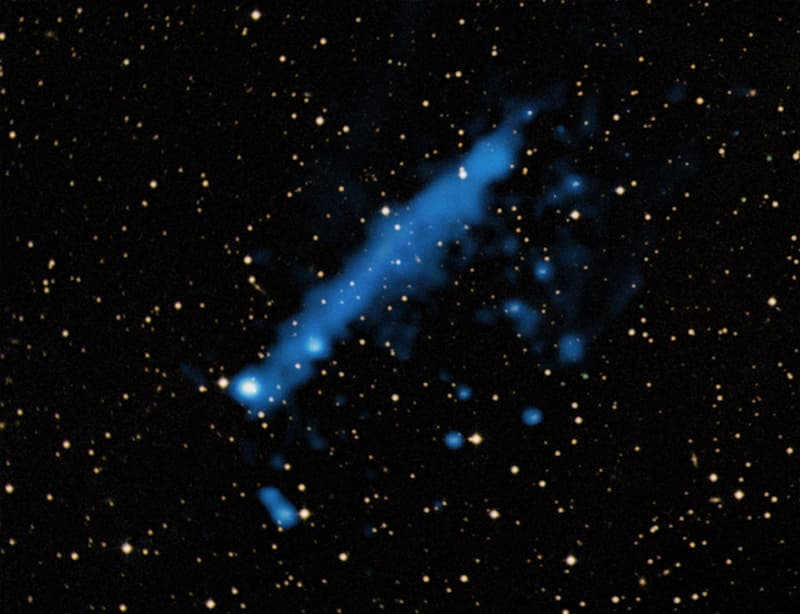
The depiction of Typhon’s approach to Earth, as described by Apollodorus in 146 BC, paints a picture of a mythical creature encircled by rings of smoke and reaching the heights of the stars with its hundred-headed dragon-like form. This colossal being upheaved mountains and extended its arms in both the western and eastern directions. According to ancient accounts, Typhon possessed an immense size and hurled stones adorned with flames.
In his work “Natural History” from 77 AD, Pliny recounts the frightening appearance of a comet witnessed by the people of Ethiopia and Egypt. This celestial body spun like a yule log, instilling fear and terror in those who beheld it. Tiphon, the ruler of that era, decreed that the fiery orb be named after himself.
These accounts are merely a fraction of what ancient civilizations had to say about the celestial body that struck fear into their hearts and compelled them to gaze skyward. The neutron star, it seems, may have been the source of their trepidation. Nevertheless, stars and other cosmic entities have perpetually captivated human attention, igniting our imaginations, enchanting us, and provoking contemplation that within the vast cosmos lies a great deal of the unknown, awaiting discovery.
Neutron stars, second only to black holes in terms of density, exist within the universe. They are the extraordinarily compressed remnants of massive stars that emerge following a supernova explosion. The level of compression is so extreme that a mass equal to that of the Sun would be condensed into a space no larger than a city.
What is the process of Neutron Star formation?
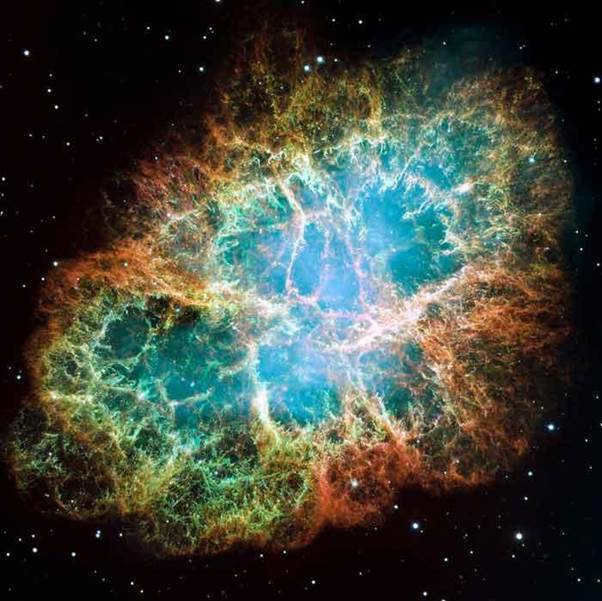
A supernova is the result of a massive star exploding at the end of its life. Stars that are approximately ten times larger than our Sun undergo a violent and energetic explosion known as a supernova. This explosion occurs when the star has depleted all of its nuclear fuel and can no longer sustain nuclear fusion. Without nuclear fusion, the star is unable to counteract the force of gravity, leading to a sudden collapse and the formation of a supernova.
Characteristics of neutron stars
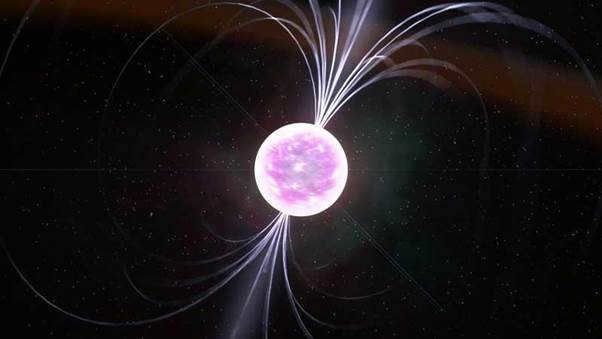
Neutron stars, found in our vast Universe, are some of the most peculiar celestial objects. One of their most notable characteristics is their extraordinary density, measuring approximately 10-17 kg/ m3. Their density is so immense that if you were to transport a spoonful of neutron star material to Earth, it would amount to a staggering weight of 1 billion tons. Furthermore, if you were to release that spoonful of neutron star material on Earth, it would effortlessly penetrate through the planet’s surface without any obstruction.
Gravity – Neutron stars possess an immense gravitational force in comparison to all other objects in our universe, except for black holes. Their gravity is approximately 2 billion times stronger than that of Earth. This extraordinary level of gravity is a result of their extreme compactness.
Magnetic Field – Similarly to density and gravity, neutron stars also exhibit the most powerful magnetic fields. The magnetic field of any neutron star surpasses the Earth’s magnetic field by more than a trillion times. Consequently, they are recognized as the most potent magnets in the Universe.
Various Categories of Neutron Stars
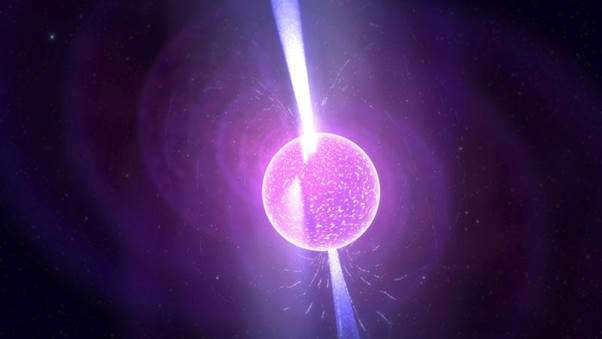
A pulsar is a type of neutron star
In our universe, there are various classifications for neutron stars based on their properties. Pulsars and magnetars are the two most common types.
Pulsars are very similar to regular neutron stars, with the exception that they emit pulses of matter and high-energy electromagnetic radiation, which are accelerated to nearly the speed of light. These particles and radiation are emitted in a pulsating manner due to the rotation of the neutron stars. Scientists have even discovered a potential use for pulsars in spacecraft navigation in the future.
Magnetars are an extraordinary type of neutron star with a magnetic field that surpasses that of a typical neutron star by more than a thousand times. These celestial bodies possess the most potent magnetic forces in the entire Universe, so intense that they obliterate the atoms in their vicinity. Furthermore, the crust of a neutron star is the most durable substance known to humanity. However, the magnetic field of a magnetar has the ability to rupture its own crust, a phenomenon referred to as a starquake. During such an event, magnetars discharge an astonishing amount of energy in just 0.1 seconds, surpassing the total energy output of our Sun over a span of 100,000 years.
The Statistics
● Up to now, astronomers have identified 2,000 neutron stars within our vast universe.
● When two neutron stars collide, a remarkably powerful explosion called a kilonova takes place. This extraordinary event triggers the creation of precious metals, including gold, and various other elements that are unable to form during a typical supernova.
● There exist certain neutron stars that remain unclassified due to their intermittent transition between being a pulsar and a magnetar.

At present, there are a total of 58,756 educational establishments that qualify for additional combined reductions (ranging from 2% to 25%). To determine the specific discount applicable to all staff members at your educational institution, please log into your personal Infoworks account.


Course for professional development
Implementing librarian activities in the field of professional education
In addition to this promotion, there is also a discount available for your educational institution, which is determined by the number of colleagues who have enrolled in the Infowork course.
Currently, a total of 58,756 educational institutions are offering additional discounts ranging from 2% to 25%. To find out the specific discount available to all employees at your educational institution, please log in to your personal Infoworks account.


Enroll in our professional retraining course
Learn how to manage electronic services for archives, libraries, and information and library centers
We are pleased to offer a discount to your educational institution. The amount of the discount will depend on the number of colleagues from your institution who have already taken Infoworks courses.
Currently, 58,756 educational institutions are benefiting from additional discounts ranging from 2% to 25%. To find out the discount available for all employees of your educational institution, simply log in to your personal Infoworks account.




Pedagogy and Art History. Exploring the Connections
Breakdown of the Presentation by Slide:

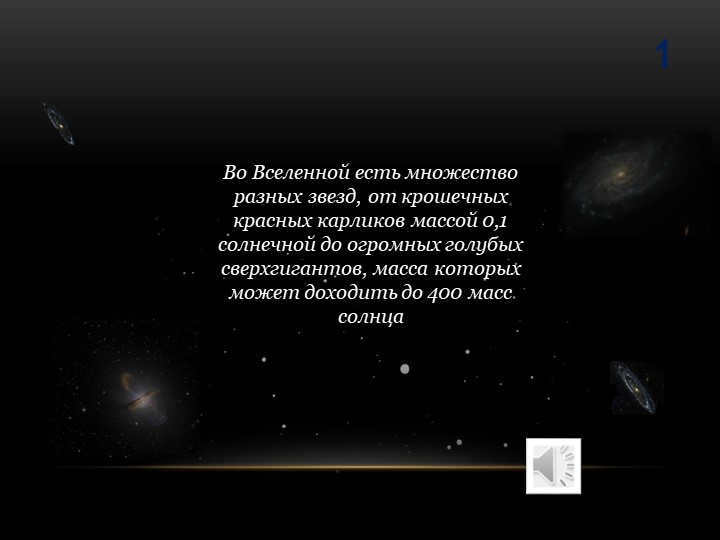
On the second slide, you will learn about the various types of stars found in the vast expanse of the universe. These celestial objects range from diminutive red dwarfs, weighing a mere 0.1 times the mass of our sun, to colossal blue supergiants, which can boast masses reaching 400 times that of our sun.
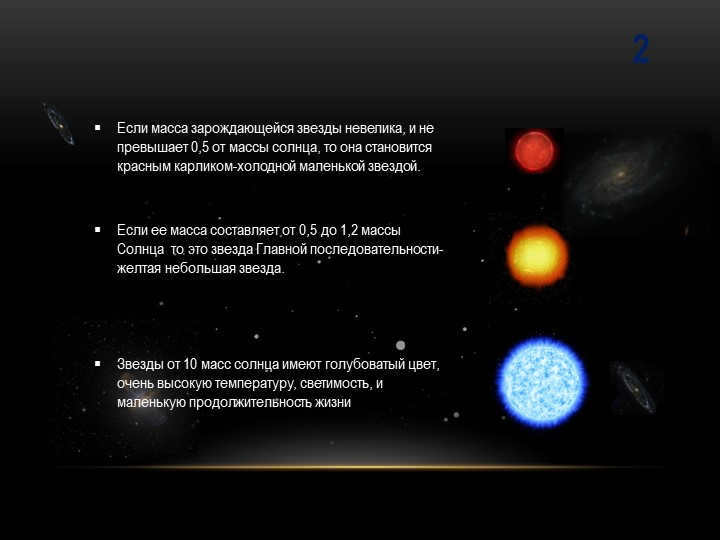
3 slide 2
If the mass of a young star is tiny and does not exceed 0.5 times the mass of the sun, it transforms into a red dwarf – a small and cool star.
If its mass falls between 0.5 and 1.2 solar masses, it becomes a Main Sequence star – a small yellow star.
Stars with a mass of 10 solar masses or more exhibit a blue shade, possess extremely high temperature and luminosity, and have a short lifespan.
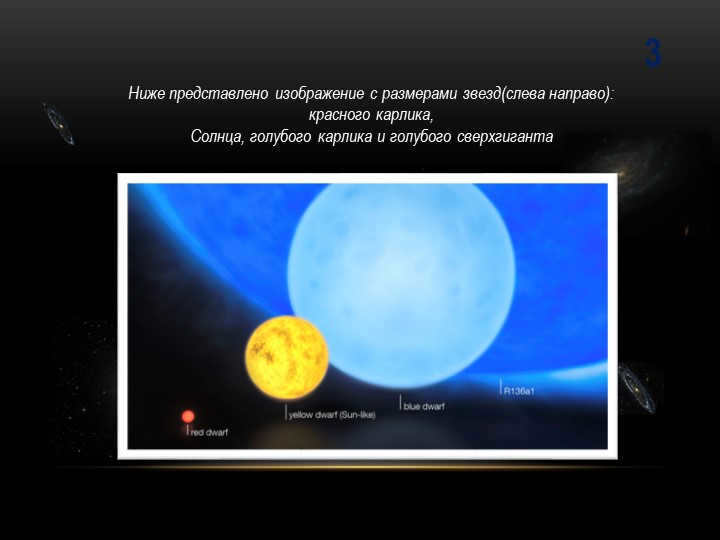
Slide 4, Slide 3
Here we have an image depicting the various sizes of stars from left to right:
a red dwarf,
the Sun,
a blue dwarf, and
a blue supergiant.


Slide 5
Big, hot stars rapidly deplete their hydrogen and other element supplies through nuclear fusion. Within a few million years of formation, the star’s core burns through all its elements, resulting in the production of iron, which cannot sustain the necessary nuclear reactions for the star.
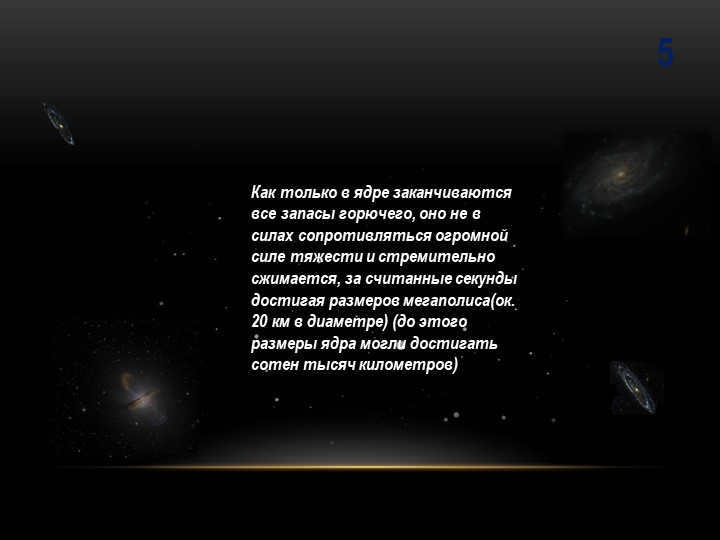
Slide 6: When the fuel within the core is depleted, it becomes incapable of withstanding the immense gravitational force and undergoes a rapid contraction, condensing to the size of a megalopolis in mere seconds (previously, the nucleus could span hundreds of thousands of kilometers in diameter, but now it measures only 20 km).
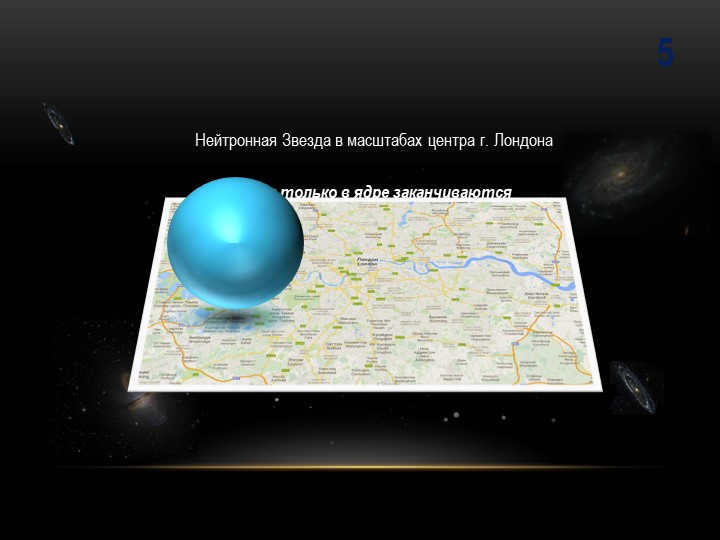
Slide 7.
Once the fuel in the core is depleted, it becomes incapable of withstanding the immense gravitational force and undergoes a rapid contraction. In a matter of seconds, it collapses to a size comparable to that of a megalopolis, approximately 20 km in diameter (previously, the core could have been hundreds of thousands of kilometers). This condensed core transforms into a Neutron Star, which is roughly the size of the central area of London.
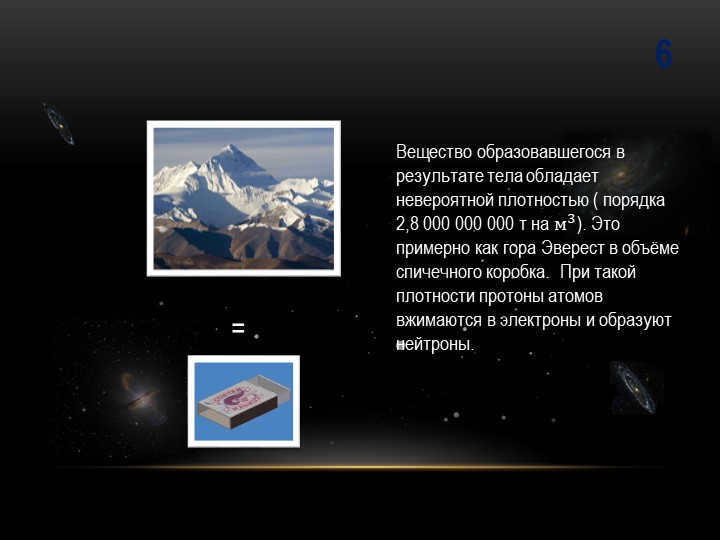
Slide 8, 6th point.
The density of the resulting body is extremely high, equivalent to approximately 2.8 sextillion tons per cubic meter. To put it in perspective, this is similar to the volume of Mount Everest compressed into the size of a matchbox. Such high density causes the protons in atoms to compress into electrons, resulting in the formation of neutrons.
=
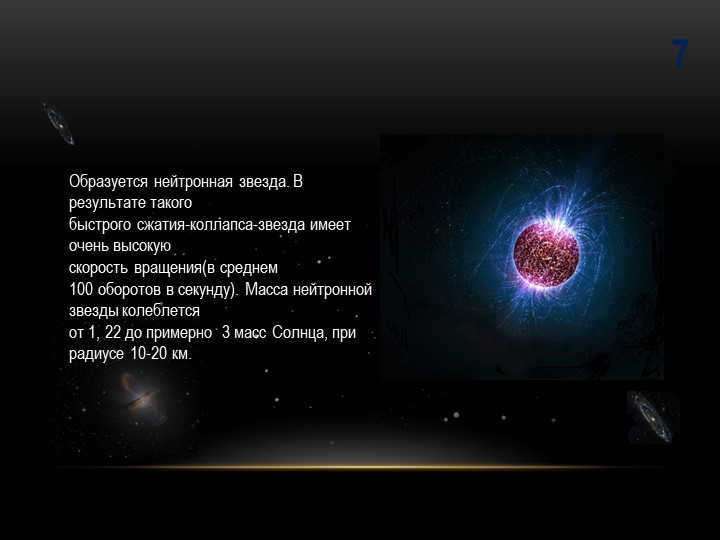

Slide 9, 7th slide
A neutron star is created through the process of rapid compression-collapse. This phenomenon leads to the development of an extremely high rotational velocity for the star, reaching up to 100 revolutions per second. The mass of a neutron star typically falls within the range of 1.22 to 3 times that of the Sun, while its radius measures between 10 to 20 kilometers.
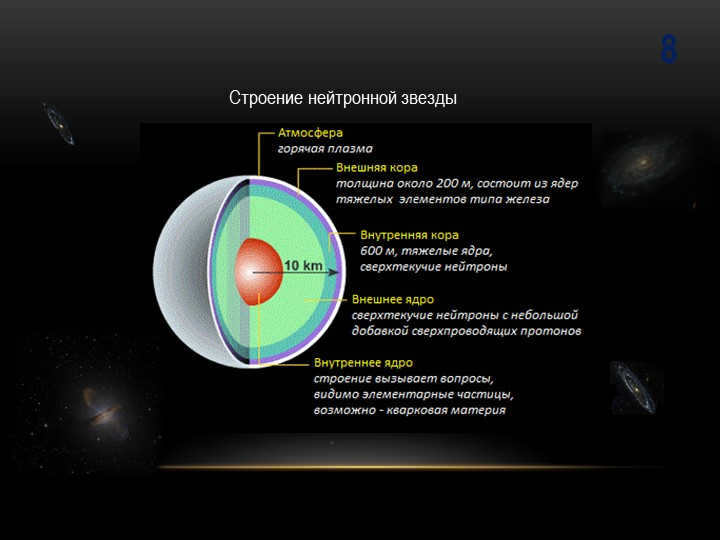
Slide 11, point 9.
In the month of June in the year 1967, a group of British scientists made a remarkable discovery – a peculiar radio signal that repeated itself at regular intervals in outer space. Initially, there was a genuine belief among scientists that this signal could possibly be a communication from intelligent beings beyond our planet, and as a result, this information was kept classified. However, further investigations revealed that the origin of these signals was a neutron star that was rotating rapidly, emitting radio waves and charged particles from its poles. Due to a slight tilt of the star’s axis in relation to Earth, a distinct and periodic signal was observed. This source of radiation became known as a pulsar.
The initial pulsar oscillations
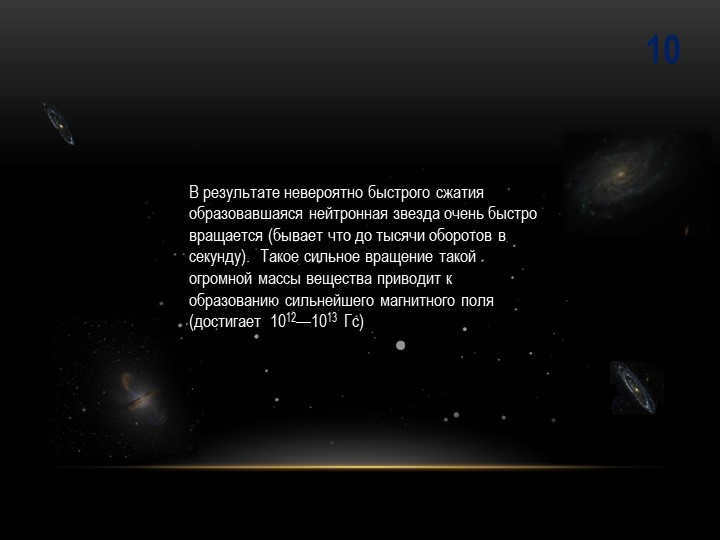
12 slide 10
The neutron star is formed as a result of an extremely rapid compression process, causing it to rotate at an astonishing speed (sometimes up to a thousand revolutions per second). This rapid rotation, combined with its enormous mass, gives rise to an immensely powerful magnetic field (reaching levels of 1012-1013 Gs).
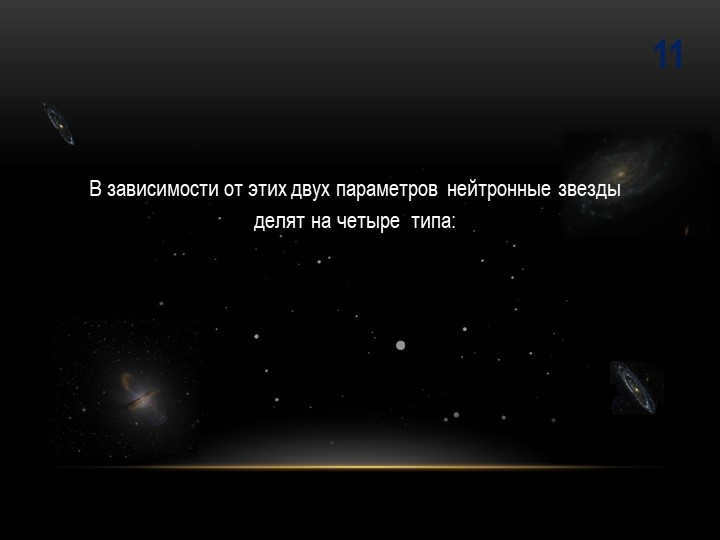
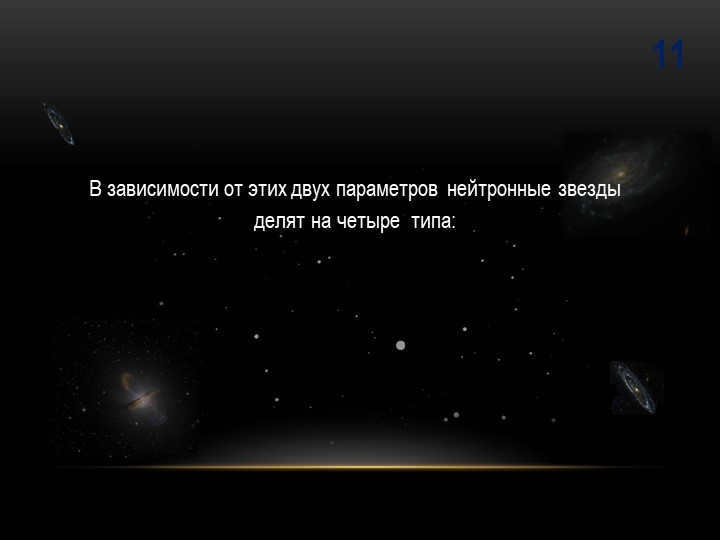
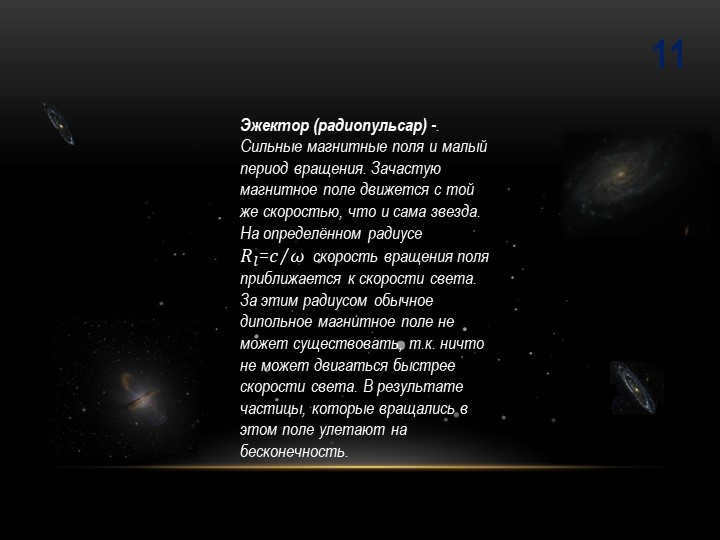
Slide 15
The radio pulsar known as the Ejector is characterized by its strong magnetic fields and rapid rotation period. It is common for the magnetic field to move at the same velocity as the star. At a specific radius 𝑅 𝑙 = 𝑐 𝜔, the rotational velocity of the magnetic field reaches the speed of light. Any radius beyond this point cannot sustain a conventional dipole magnetic field as no object can surpass the speed of light. Consequently, particles that have been affected by this field are propelled into infinite distances.
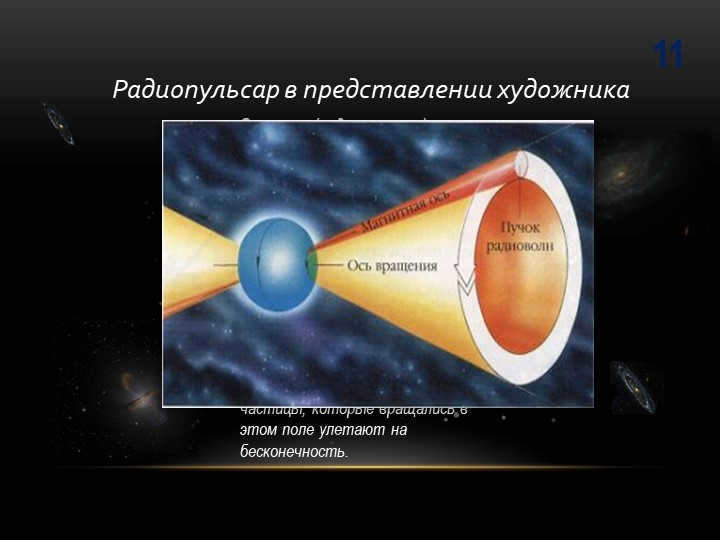
Slide 16, Number 11
Ejector (radio pulsar) – characterized by intense magnetic fields and a short rotation period. In many cases, the magnetic field rotates at the same speed as the star itself. At a specific radius 𝑅 𝑙 = 𝑐 𝜔, the rotational velocity of the magnetic field reaches the speed of light. Beyond this radius, a typical dipole magnetic field cannot exist as nothing can travel faster than the speed of light. Consequently, particles that were previously rotating within this field disperse infinitely into space.
An artist’s depiction of a radio pulsar
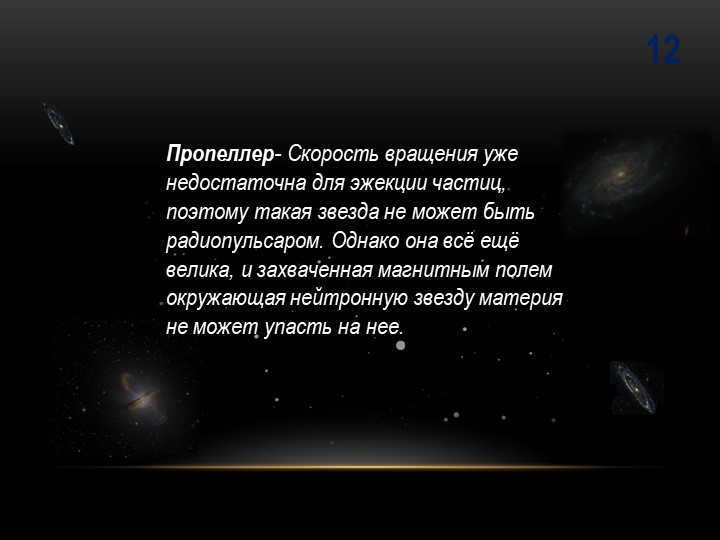
Slide 17, number 12.
A propeller system – The rotational speed is already not enough for the expulsion of particles, thus making it impossible for this star to be a radio pulsar. However, it still has a significant size, and the matter that is captured by the magnetic field surrounding the neutron star is unable to fall onto it.
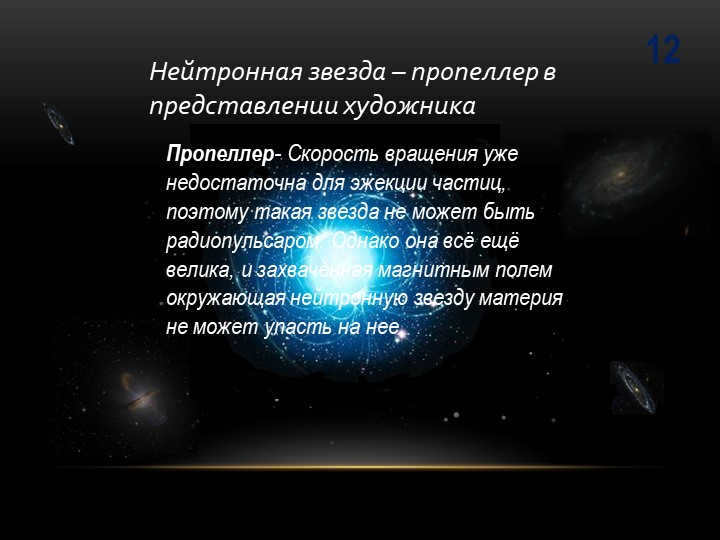
Slide 12 of 18.
Propeller- The rotational velocity is not enough for the expulsion of particles, thus making it impossible for this star to be a radio pulsar. Nevertheless, it remains sizable, and the material trapped by the magnetic field encircling the neutron star cannot collapse onto it.
The neutron star acts as a propeller in the artist’s conception.
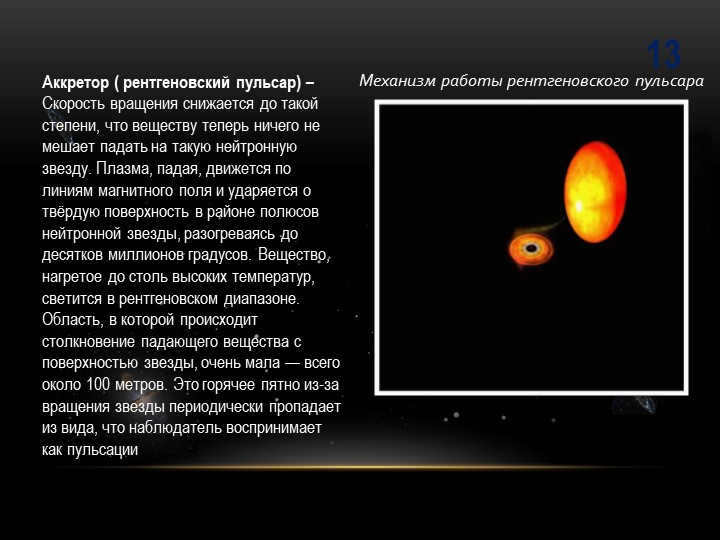
Slide 19, slide 13
Accretor (X-ray pulsar) –
The rotational speed decreases to the extent that there is no longer any obstacle to prevent the matter from falling onto a neutron star of this kind. As the plasma falls, it moves along the magnetic field lines and strikes the solid surface near the poles of the neutron star, heating up to tens of millions of degrees. Matter heated to such high temperatures emits light in the X-ray range. The region where the falling matter collides with the star’s surface is very small – only about 100 meters. This hot spot periodically disappears from view due to the star’s rotation, creating pulsations that are perceived by the observer.
Mechanism of operation of an X-ray pulsar
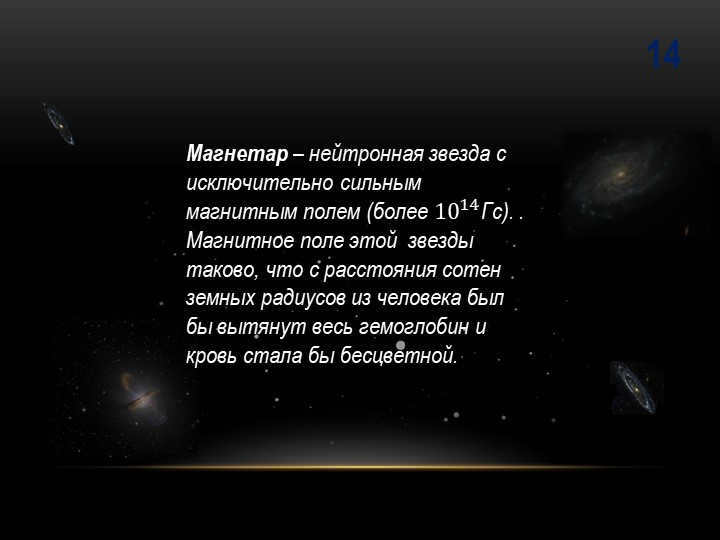
Slide 20
A magnetar is a type of neutron star that possesses an incredibly powerful magnetic field, surpassing 10^14 Gs. The magnetic strength of this celestial body is so intense that, from a distance equivalent to hundreds of Earth radii, it would be capable of extracting all hemoglobin from a person’s body, resulting in colorless blood.
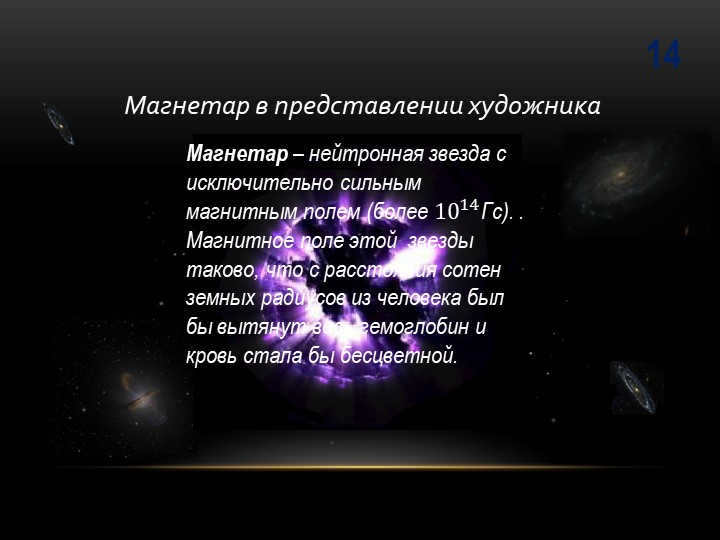
Slide 21, number 14.
The artist’s visualization of a Magnetar
A Magnetar is a type of neutron star that possesses an incredibly powerful magnetic field, measuring over 10^14 Gauss. The magnetic field of this celestial body is so strong that if a person were located hundreds of Earth radii away, the magnetic force would extract all the hemoglobin from their body, resulting in colorless blood.
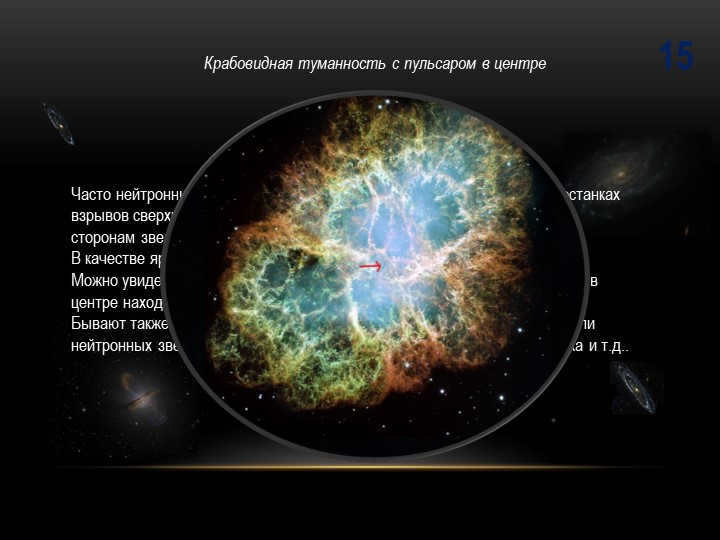
Slide 22.
Neutron stars are frequently discovered in their original environments, which are the remains of supernova explosions known as planetary nebulae.
A notable example is the Crab Nebula.
One can observe the stellar gas dispersing in all directions, while a compact neutron star resides at the center.
There are also instances of solitary neutron stars, neutron stars orbiting white dwarfs, and other configurations.
The Crab Nebula features a pulsar at its core.
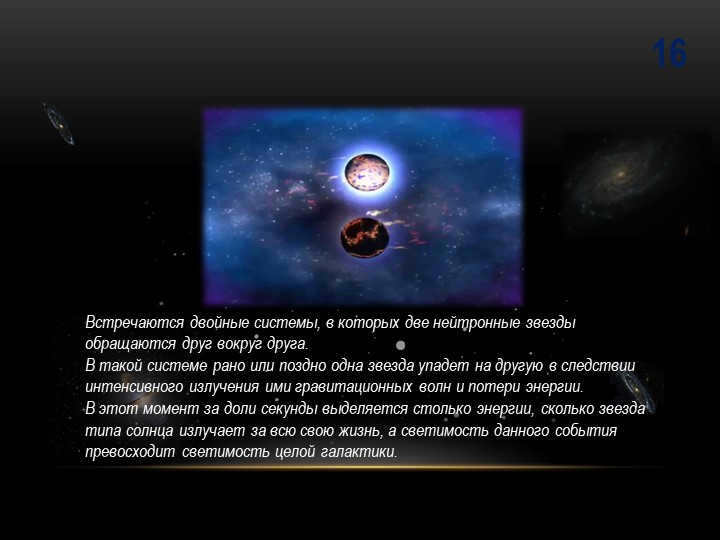
Slide 23
Neutron stars can form double systems where they revolve around each other.
Within such a system, one star will eventually collapse onto the other due to the intense emission of gravitational waves and the loss of energy.
During this moment, an enormous amount of energy is released in a fraction of a second, surpassing the total energy emitted by a sun-like star throughout its entire lifetime, and the brightness of this event exceeds that of an entire galaxy.
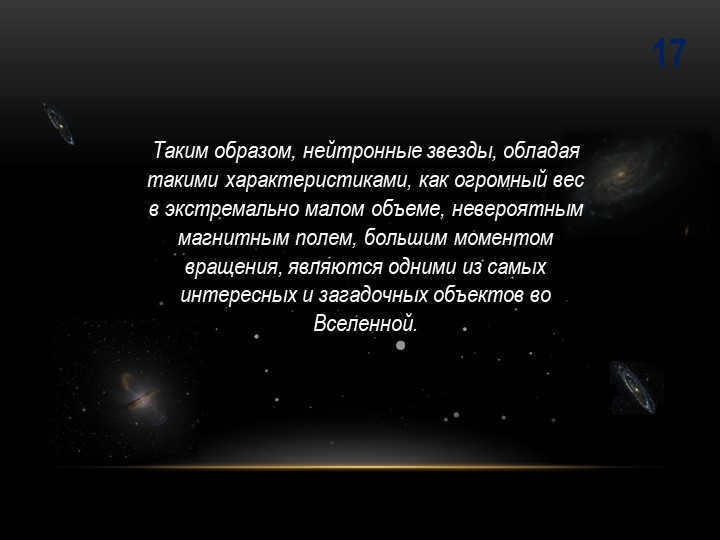
Slide number 24, section 17.
Therefore, neutron stars are considered to be one of the most captivating and enigmatic entities in the vast expanse of the Universe, primarily due to their extraordinary mass confined within an incredibly compact volume, their astonishing magnetic field, and their significant rotational momentum.


27 slide Lists of interesting literature :
Stars: their birth, life and death. Shklovsky I.S./ I. Nauka – 1984g./ Chap. 19 – 23.
Black holes, white dwarfs and neutron stars. Shapiro S.L., Tjukolski S.A./-1984.
Lists of intriguing Internet resources on the topic:
http://www.popmech.ru/
http://elementy.ru/
http://www.litmir.me/br/?b=19340&p=71
Lists of captivating movies and media presentations on the topic:
Universe Evacuation from Earth. Neutron star. National Geographic Channel/ /2008.
The Universe (TV series) Season 4, Episode 10. Pulsars and Quasars.
Author of the presentation: Ognev V.V.
For any inquiries, please contact: [email protected]
- Certifications for portfolio
- Eternal access for only 99 rubles
- Over 3,800 video lectures for everyone
A neutron star is an extremely fast-spinning object that remains after a supernova star explodes. Measuring just 20 kilometers in diameter, this object has a mass comparable to that of the Sun. Under Earth conditions, a mere gram of a neutron star would weigh more than 500 million tons! This incredible density is a result of electrons being squeezed into the nuclei, where they combine with protons to form neutrons. In fact, neutron stars share many properties with atomic nuclei, including their density and composition. However, there is one key difference: while nucleons in nuclei are bound by strong interactions, in stars they are bound by the force of gravity.
What are neutron stars?
The composition of neutron stars
The composition of these celestial bodies (due to obvious reasons) has only been explored in theoretical studies and mathematical calculations thus far. Nevertheless, significant knowledge has already been acquired. As implied by their name, they primarily consist of densely packed neutrons.
A neutron star’s atmosphere is merely a few centimeters thick, yet it encompasses all of its thermal radiation. Beyond the atmosphere lies the crust, which is composed of tightly packed ions and electrons. At the core resides the nucleus, comprising neutrons. Closer to the center, the matter reaches its maximum density, which is 15 times that of nuclear density. Neutron stars are the most compact objects in the cosmos. Any attempt to further increase the density of matter would result in its collapse into a black hole or the formation of a quark star.
Magnetic Field
Neutron stars can rotate at speeds of up to 1000 revolutions per second, while simultaneously generating magnetic fields of colossal proportions due to the presence of electrically conducting plasma and nuclear matter.
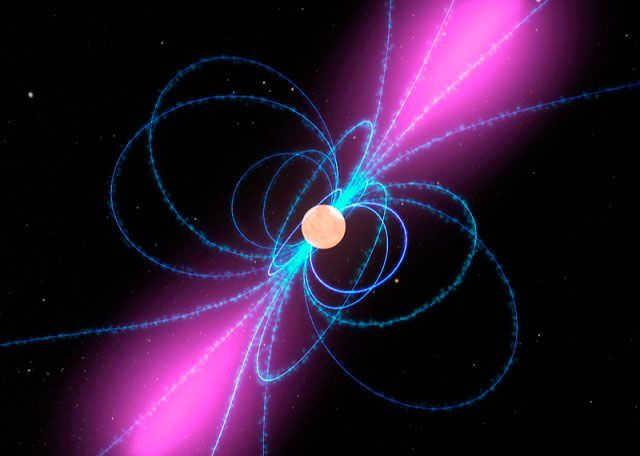
For instance, while the Earth’s magnetic field measures at -1 gauss, the magnetic field of a neutron star is an astounding 10,000,000,000,000,000,000,000 gauss. In comparison, the strongest artificially produced magnetic field would be billions of times less powerful.
Various Categories of Neutron Stars
Pulsating Neutron Stars
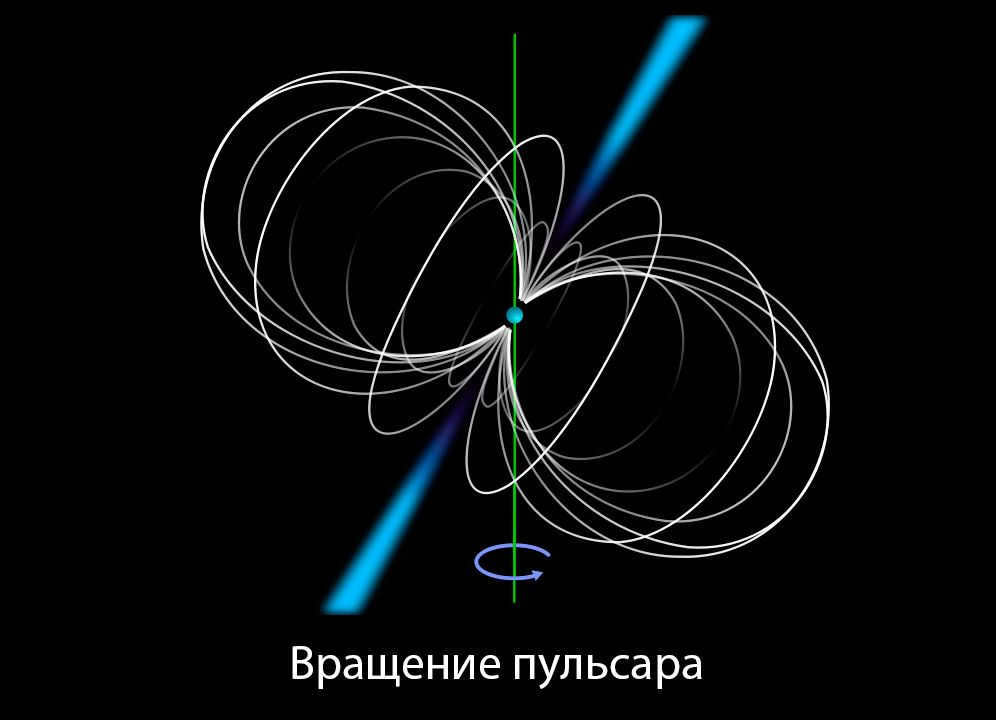
Neutron stars are commonly referred to as pulsars. Pulsars possess a well-defined period of rotation that remains constant over a significant period of time. This unique characteristic has led to their nickname as the “guiding lights of the cosmos”.
High-speed particles are ejected through the poles in a concentrated stream, resulting in the emission of radio waves. Due to the misalignment of their rotational axes, the direction of the stream constantly changes, creating a lighthouse-like effect. Similar to any lighthouse, pulsars emit distinct signals at specific frequencies, allowing for their identification.
Most of the identified neutron stars are found in binary X-ray systems or as solitary pulsars.
The Phenomenon of Magnetars
When a neutron star is born, it spins very quickly and generates a massive magnetic field due to its rotation and convection processes, known as the “active dynamo.” This magnetic field is much stronger than that of regular pulsars, surpassing them by tens of thousands of times. Although the dynamo activity lasts only 10-20 seconds, the star’s atmosphere cools down during this time, allowing the magnetic field to regenerate. However, this regenerated field is unstable and rapidly changes its structure, resulting in the release of an enormous amount of energy. This process ultimately leads to the star’s self-destruction as its magnetic field tears it apart. There are approximately a dozen potential magnetars in our galaxy. These magnetars can only form from stars that are at least 8 times more massive than our Sun and have a diameter of around 15 kilometers, with a mass comparable to that of the Sun. Nonetheless, definitive evidence confirming the existence of magnetars is still lacking.
X-ray pulsars.
X-ray pulsars are regarded as a distinct stage in the lifecycle of a magnetar, emitting radiation exclusively in the X-ray spectrum. The emissions are a result of periodic explosions.
Some neutron stars can be found in binary systems or acquire a companion through gravitational capture. When a companion neutron star, which is not less massive than the Sun, is present, it can lead to interesting phenomena known as barsters. These barsters manifest as short-lived X-ray flares that can last for seconds or minutes, but during this time, they can increase the luminosity of the star to 100,000 times that of the Sun. The barster is formed when hydrogen and helium from the companion star accumulate on the surface of the neutron star. As the layer becomes denser and hotter, it triggers a thermonuclear reaction. The power unleashed by such an explosion is immense, with each square centimeter of the star releasing energy equivalent to the detonation of the entire nuclear potential of planet Earth.
When there is a massive companion nearby, the neutron star loses matter through stellar wind, while its gravity pulls it in. The particles travel along magnetic field lines toward the poles. If the alignment of the magnetic and rotational axes is off, the star’s brightness will fluctuate, resulting in an X-ray pulsar.
These objects are also linked to binary systems and possess the shortest periods (less than 30 milliseconds). Contrary to what was initially thought, they are not the youngest but rather quite ancient. An aged and sluggish neutron star engulfs the material from a massive companion. As the material falls onto the surface of the intruder, it imparts rotational energy, causing the star to spin faster. Over time, the companion will evolve into a white dwarf, shedding mass.
Exoplanets around neutron stars.
The initial discovery of an exoplanet occurred during the investigation of a radio pulsar. Due to the remarkable stability of neutron stars, it is feasible to accurately monitor neighboring planets that have significantly smaller masses than Jupiter.
A planetary system was easily identified near the pulsar PSR 1257 + 12, which is located approximately 1000 light years away from the Sun. In close proximity to the star, three planets were detected, with masses equivalent to 0.2, 4.3, and 3.6 times that of Earth, and with orbital periods of 25, 67, and 98 days, respectively. Subsequently, another planet with a mass similar to that of Saturn and an orbital period of 170 years was also detected. Additionally, there is knowledge of a pulsar that has a planet slightly more massive than Jupiter.
It is an ironic fact that planets can be found in close proximity to pulsars. When a neutron star is formed through a supernova explosion, it loses a significant amount of its mass. The remaining mass lacks sufficient gravitational force to keep satellites intact. Therefore, it is probable that the discovered planets were formed post-cataclysm.
The total count of identified neutron stars is approximately 1200. Out of this tally, 1000 are categorized as radio pulsars, while the remaining are recognized as X-ray sources. The exploration of these celestial bodies through the deployment of any kind of physical apparatus is unattainable. The Pioneer spacecraft transmitted messages intended for extraterrestrial intelligent lifeforms. Moreover, our solar system’s exact position is precisely indicated by its alignment with the nearest pulsars to Earth. The lines emanating from the Sun delineate the directions towards these pulsars, along with their respective distances. In addition, the dashed lines illustrate their orbital periods.





